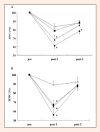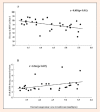Muscle activation during low-intensity muscle contractions with varying levels of external limb compression
- PMID: 24149952
- PMCID: PMC3761922
Muscle activation during low-intensity muscle contractions with varying levels of external limb compression
Abstract
The purpose was to investigate muscle activation during low- intensity muscle contractions with various levels of external limb compression to reduce muscle perfusion/outflow. A series of unilateral elbow flexion muscle contractions (30 repetitive contractions followed by 3 sets x 15 contractions) was performed at 20% of 1RM with varying levels of external compression (0 (without compression), 98, 121, and 147 mmHg external compression) around the upper arm. Electromyography (EMG) signals were recorded from surface electrodes placed on the biceps brachii muscle and analyzed for integrated EMG (iEMG). Maximal voluntary isometric contraction (MVC) decreased similarly during the control (0 mmHg) and 98 mmHg external compression bout (~18%); the decline in MVC with 121 and 147 mmHg external compression was significantly greater (~37%). Muscle activation increased progressively throughout the contraction bout with each level of external compression, but iEMG was significantly greater during 147 mmHg external compression. In conclusion, low-intensity muscle contractions performed with external compression of 147 mmHg appears to alter muscle perfusion/outflow leading to increased muscle activation without decrements in work performed during the contraction bout. Key pointsLow-intensity muscle contractions with external compression are maintained by greater neural activation.It appears there is optimal external compression pressure for increased muscle activation without exaggerated fatigue.External compression per arm circumference was related to the neuromuscular response and fatigue.
Keywords: EMG; Neuromuscular function; biceps brachii; cuff pressure; ischemia.
Figures





References
-
- Abe T., DeHoyos D.V., Pollock M.L., Garzarella L. (2000) Time course for strength and muscle thickness changes following upper and lower body resistance training in men and women. European Journal of Applied Physiology 881, 174-180 - PubMed
-
- Abe T., Yasuda T., Midorikawa T., Sato Y., Kearns C.F., Inoue K., Koizumi K., Ishii N. (2005) Skeletal muscle size and circulating IGF-1 are increased after two weeks of twice daily “KAATSU” resistance training. International Journal of KAATSU Training Research 1, 6-12
-
- Astrand P.O., Rodahl K. (1970) Textbook of work physiology. New York: McGraw-Hill
-
- Bigland-Ritchie B., Cafarelli E., Vollestad N.K. (1986a) Fatigue of submaximal static contractions. Acta Physiologica Scandinavica (Supplement) 556, 137-148 - PubMed
LinkOut - more resources
Full Text Sources
